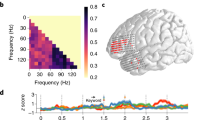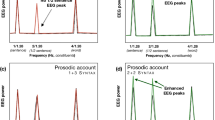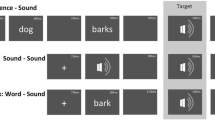Abstract
The neural network supporting aspects of syntactic, prosodic, and semantic information processing is specified on the basis of two experiments using functional magnetic resonance imaging (fMRI). In these two studies, the presence/absence of lexical-semantic and syntactic information is systematically varied in spoken language stimuli. Inferior frontal and temporal brain areas in the left and the right hemisphere are identified to support different aspects of auditory language processing. Two additional experiments using event-related brain potentials investigate the possible interaction of syntactic and prosodic information, on the one hand, and syntactic and semantic information, on the other. While the first two information types were shown to interact early during processing, the latter two information types do not. Implications for models of auditory language comprehension are discussed.
Similar content being viewed by others
REFERENCES
Cabeza, R., & Nyberg, L. (2000). Imaging Cognition II: An Empirical Review of 275 PET and fMRI studies. Journal of Cognitive Neuroscience, 12, 1–47.
Caplan, D., Alpert, N., & Waters, G. (1998). Effects of syntactic structure and propositional number on patterns of regional cerebral blood flow. Journal of Cognitive Neuroscience, 10, 541–552.
Caplan, D., & Waters, G. S. (1999). Verbal working memory and sentence comprehension [Review]. Behavioral Brain Sciences, 22, 114–126.
Dapretto, M., & Bookheimer, S. Y. (1999). Form and content: Dissociating syntax and semantics in sentence comprehension. Neuron, 24, 427–432.
Dronkers, N. F., Wilkins, D. P., Redfem, B. B., Van Valin, J. R., & Jaeger, J. J. (1994). A reconsideration of the brain areas involved in the disruption of morphosyntactic comprehension. Brain and Language, 47, 461–463.
Fiez, J. A. (1997). Phonology, semantics, and the role of the left inferior prefrontal cortex. Human Brain Mapping, 5, 79–83.
Frazier, L. (1978). On comprehending sentences: Syntactic parsing strategies. Doctoral Dissertation, University of Connecticut.
Frazier, L. (1987). Theories of sentence processing. In J. Garfield (Ed.), Modularity in knowledge representation and natural-language processing. Cambridge, MA: MIT Press.
Frazier, L. (1995). Constraint satisfaction as a theory of sentence processing. Journal of Psycholinguistic Research, 24, 437–468.
Frazier, L., & Fodor, J. D. (1978). The sausage machine: A new two-stage parsing model. Cognition, 6, 291–325.
Friederici, A. D. (1995). The time course of syntactic activation during language processing: A model based on neuropsychological and neurophysiological data. Brain and Language, 50, 259–281.
Friederici, A. D. (1999). The neurobiology of language comprehension. In A. D. Friederici (Ed.), Language comprehension: A biological perspective,2nd (pp. 265–304). Berlin: Springer.
Friederici, A. D., Pfeifer, E., & Hahne, A. (1993). Event-related brain potentials during natural speech processing: Effects of semantic, morphological and syntactic violations. Cognitive Brain Research, 1, 183–192.
Friederici, A. D., Meyer, M., & von Cramon, D. Y. (2000a). Auditory language comprehension: An event-related fMRI study on the processing of syntactic and lexical information. Brain and Language, 74, 289–300.
Friederici, A. D., Opitz, B., & von Cramon, D. Y. (2000b). Segregating semantic and syntactic aspects of processing in the human brain: An fMRI investigation of different word types. Cerebral Cortex, 10, 698–705.
Friederici, A. D., Wang, Y., Herrmann, C. S., Maess, B., & Oertel, U. (2000c). Localisation of early syntactic processes in frontal and temporal cortical areas: An MEG study. Human Brain Mapping, 11(1), 1–11.
Gorrell, P. (1995). Syntax and parsing. Cambridge, MA: Cambridge University Press.
Gunter, T. C., Friederici, A. D., & Schriefers, H. (2000). Syntactic gender and semantic expectancy: ERPs reveal early autonomy and late interaction. Journal of Cognitive Neuroscience, 12, 556–568.
Hahne, A., & Friederici, A. D. (1999). Electrophysiological evidence for two steps in syntactic analysis: Early automatic and late controlled processes. Journal of Cognitive Neuroscience, 11, 194–205.
Hahne, A. & Friederici, A. D. (1998). ERP-evidence for autonomous first-pass parsing processes in auditory language comprehension. Journal of Cognitive Neuroscience, Supplement, 125.
Just, M. A., Carpenter, P. A., Keller, T. A., Eddy, W. F., & Thulbom, K. R. (1996). Brain activation modulated by sentence comprehension. Science, 274, 114–116.
MacDonald, M. C. (1993). The interaction of lexical and syntactic ambiguity. Journal of Memory and Language, 32, 692–715.
McClelland, J. (1987). The case of interactionism in language processing. In M. Coltheart (Ed.), Attention and performance XII: The psychology of reading (pp. 3–36), Hillsdale, NJ: Erlbaum.
Marslen-Wilson, W. D., & Tyler, L. K. (1980). The temporal structure of spoken language understanding. Cognition, 8, 1–71.
Marslen-Wilson, W. D., Tyler, L. K., Warren, P., Genier, P., & Lee, C. S. (1992). Prosodic effects in minimal attachment. Quarterly Journal of Experimental Psychology, 45A, 73–87.
Mazoyer, B. M., Tzourio, N., Frak, V., Syrota, A., Murayama, N., Levrier, O., Salamon, G., Dehaene, S., Cohen, L., & Mehler, J. (1993). The cortical representation of speech. Journal of Cognitive Neuroscience, 5, 467–479.
Meyer, M., Friederici, A. D., & von Cramon, D. Y. (2000). Neurocognition of auditory sentence comprehension: Event-related fMRI reveals sensitivity to syntactic violations and task demands. Cognitive Brain Research, 9, 19–33.
Müller, R.-A., Rothermel, R. D., Behen, M. E., Muzik, O., Mangner, T. J., & Chugani, H. T. (1997). Receptive and expressive language activations for sentences: A PET study. Neuroreport, 8, 3767–3770.
Ni, W., Constable, R. T., Menci, W. E., Pugh, K. R., Fulbright, R. K., Shaywitz, S. E., Shaywitz, B. A., Gore, J. C., & Shankweiler, D. (2000). An Event-related Neuroimaging Study Distinguishing Form and Content in Sentence Processing. Journal of Cognitive Neurosciences, 12, 120–133.
Pynte, J., & Prieur, B. (1996). Prosodic breaks and attachment decisions in sentence parsing. Language and Cognitive Processes, 11, 165–192.
Schlosser, M. J., Aoyagi, N., Fulbright R. K., Gore, J. C., & McCarthy, G. (1998). Functional MRI studies of auditory comprehension. Human Brain Mapping, 6, 1–13.
Speer, S. R., Kjelgaard, M. M., & Dobroth, K. M. (1996). The influence of prosodic structure on the resolution of temporary syntactic closure ambiguities. Journal of Psycholinguistic Research, 25, 247–268.
Steinhauer, K., Alter, K., & Friederici, A. D. (1999). Brain potentials indicate immediate use of prosodic cues in natural speech processing. Nature Neuroscience, 2, 191–196.
Steinhauer, K., Alter, K., Meyer, M., Friederici, A. D., & von Cramon (1999). Brain activation related to prosodic in natural speech: An event-related fMRI study. Journal of Cognitive Neuroscience, Supplement, p. 54.
Stromswold, K., Caplan, D., Alpert, N., & Rauch, S. (1996). Localization of syntactic comprehension by positron emission tomography. Brain and Language, 52, 452–473.
Thompson-Schill, S. L., D'Esposito, M., Aguirre, G. K., & Farah, M. J. (1997). Role of left inferior prefrontal cortex in retrieval of semantic knowledge: A reevaluation. Proceedings of the Natural Academy of Science USA, 94, 14792–14797.
Warren, P., Grabe, E., & Nolan, F. (1995). Prosody, phonology, and parsing in closure ambiguities. Language and Cognitive Processes, 10, 457–486.
Watt S. M., & Murray W. S. (1996). Prosodic form and parsing commitment. Journal of Psycholinguistic Research, 25, 291–318.
Author information
Authors and Affiliations
Rights and permissions
About this article
Cite this article
Friederici, A.D. Syntactic, Prosodic, and Semantic Processes in the Brain: Evidence from Event-Related Neuroimaging. J Psycholinguist Res 30, 237–250 (2001). https://doi.org/10.1023/A:1010438900737
Issue Date:
DOI: https://doi.org/10.1023/A:1010438900737




